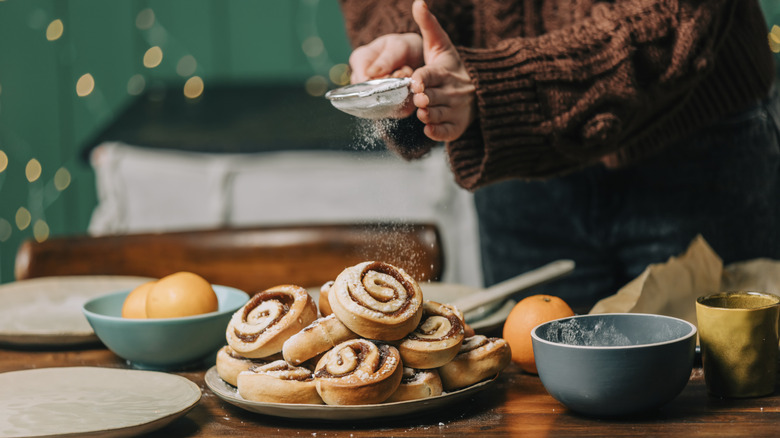The Delicious Ingredient You Should Actually Avoid For Better Cinnamon Rolls
We may receive a commission on purchases made from links.
As with most pastries, butter is an essential ingredient for gooey, decadently rich cinnamon rolls. But just like pie crusts and croissants — where your butter needs to be quite cold so that it melds with your dough, as opposed to leaking out or evaporating completely in the oven — hot or even warm butter can completely sabotage your cinnamon rolls' bake.
Unfortunately, to save time, many recipes recommend melting a stick of butter, then immediately pouring it over your large rectangle of rolled out dough. Once saturated, you then add your favorite type of cinnamon (and lots of it), sugar, and any other spices to flavor your rolls, like a dash of clove or nutmeg. But one issue with this method becomes immediately apparent.
As you start rolling up your dough into a log, moving slowly back and forth like an old-school typewriter, the melted butter starts escaping out either end, taking its own delicious flavor and that of your added sugar and spices with it. Your rolls then go into the oven without some of the critical butter that they need. Plus, hot, already melted butter disappears quickly in the oven and can't provide that extra crisp, caramelized crunch to the inside layers of your rolls.
How to incorporate butter like a pro
Professional chefs are on the case when it comes to delivering buttery cinnamon rolls. Benjamin Delwiche, the author of Dessert Course, for instance, rolls out his cinnamon roll dough in the same way you would a croissant. A stick of cold butter is folded into the rolled-out dough, like being tucked into an envelope, then rolled out flat again. This method distributes the butter evenly throughout the dough. Plus, by sandwiching the butter between the layers of dough before your final roll and cut, each layer of your spiral will take on that flaky pastry consistency, thanks to butter's presence.
If laminating your dough sounds like a headache, don't worry, there's another easier way to keep your butter inside your rolls while baking. Rather than melting your butter completely, try softening it just to room temperature. You're looking for a consistency that's easy to spread, but not so loose that it will leak out of your log of dough. Once your butter has reached perfect spreadability, mix your cinnamon, sugar, and spices directly into the butter to make a sort of cinnamon paste. This guarantees that all that delicious flavor will stay firmly inside your rolls while baking.
If you're looking to add a few more fillings to your favorite sourdough cinnamon roll recipe, like chopped pecans, dried cranberries, or orange zest, sprinkle them on top of your sheet of dough after spreading your cinnamon-butter paste, otherwise the butter mixture will be too chunky to smooth out. Try out one of these butter methods and we promise your revelatory cinnamon rolls will taste remarkably professional.

